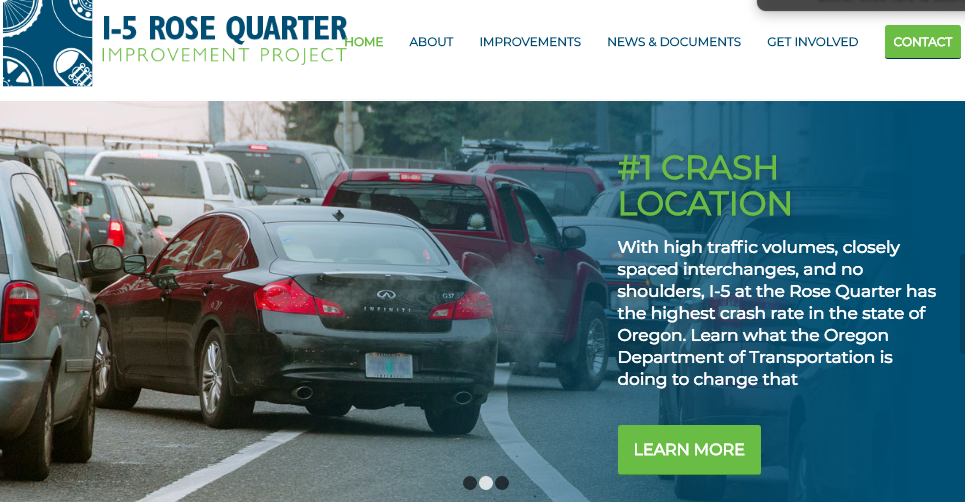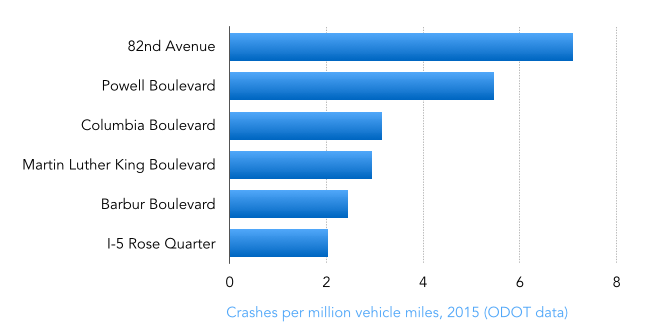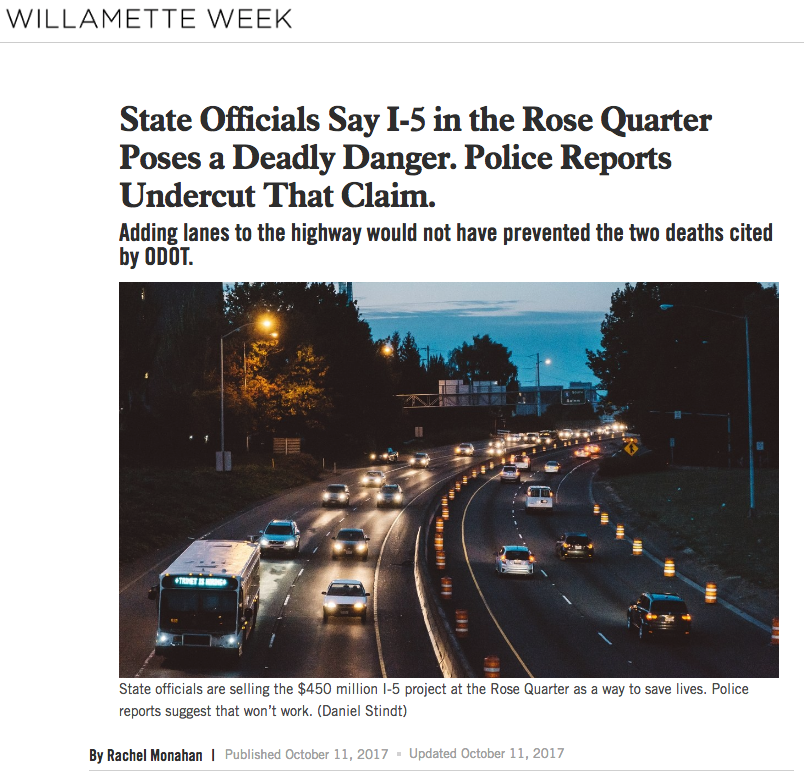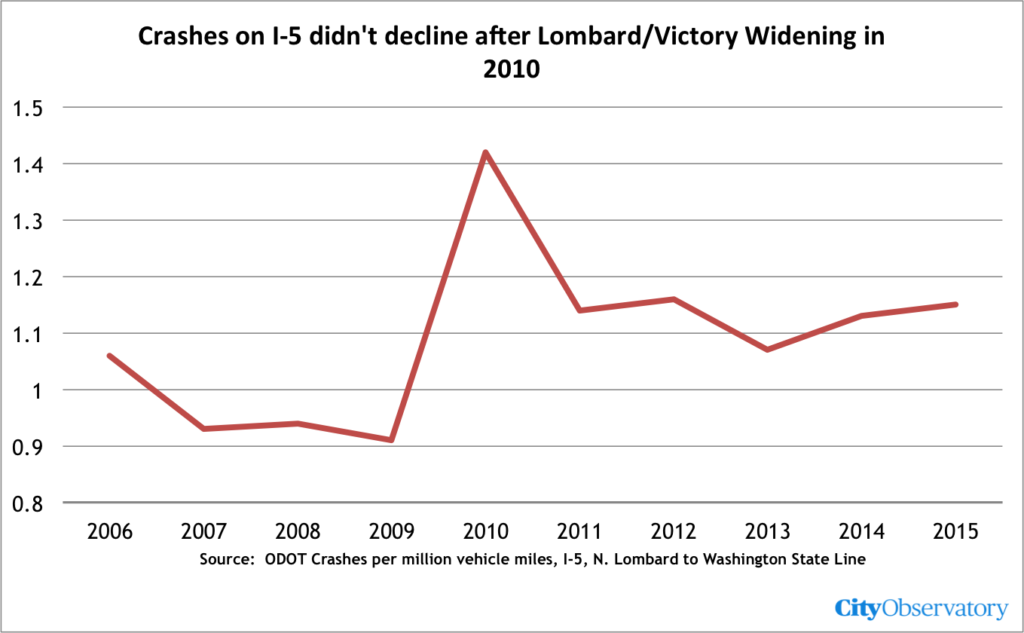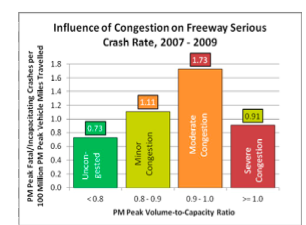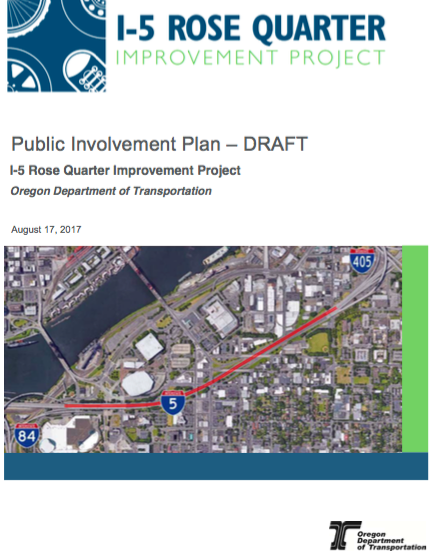Oregon’s Department of Transportation is lying about safety to sell a half billion dollar freeway project
Fear-mongering is the one of the lowest, if unfortunately most effective, means of selling anything. Threaten anyone with a danger to their health and safety, and they’ll acquiesce to a sales pitch.
Oregon’s Department of Transportation is using an utterly phony set of safety claims to try and convince the public that an ineffective freeway widening project is somehow important to improving the safety of the region’s transportation system.
Safety is a shop-worn talking point for highway advocates: We need to spend more money on roads, don’t you understand, in order to make them safer. For example, we reviewed an Oregon Department of Transportation report that used the word “crash” nearly 200 times in describing the performance of Portland area freeways.
In this era of “Vision Zero” and with roadway fatalities increasing sharply, it makes sense that we all ought to be focused on making our transportation system safer. While there are many valid and well-meaning efforts under way, at least one agency is trying, cynically, to sell a freeway widening project as a safety improvement. And they’re not averse to blatantly lying to do so.
The project in question is a proposed $500 million widening of Interstate 5 in Portland, Oregon. The project would widen a mile-long stretch of freeway opposite downtown Portland from four lanes to six. To hear the Oregon Department of Transportation tell it, this project is all about safety. According to their marketing materials, this is THE #1 CRASH LOCATION IN THE STATE OF OREGON. As the project’s website shows, they’re featuring this claim:
Sounds pretty scary, doesn’t it? There’s one problem. It’s utterly false.
ODOT’s own data show it is lying about the safety of the Rose Quarter
The Oregon Department of Transportation’s own data make it clear that the “#1 crash site” claim is factually wrong. The data produced by ODOT’s own Traffic Safety Section, which anyone can view on-line here, shows that other ODOT highways in Portland have higher crash rates. Powell Boulevard and 82nd Avenue–both places people have died in the past year, have crash rates that are two and three times higher than I-5 at the Rose Quarter.
And critically, these crash statistics make no mention of the severity of crashes. Crashes at the Rose Quarter are overwhelmingly minor, non-injury fender-benders. Crashes on these other ODOT facilities kill and maim Oregonians on a regular basis. Willamette Week reporter Rachel Monahan comprehensively de-bunked ODOTs claims about serious injuries on the roadway in her article “State Officials Say I-5 in the Rose Quarter Poses a Deadly Danger. Police Reports Undercut that Claim.” True, two pedestrians have died on I-5, both either mentally ill or intoxicated while attempting to walk across the freeway–something this project would do nothing to address. “The primary purpose of this project is to address a critical safety need,” told Willamette Week ODOT spokesman Don Hamilton.
It’s dishonest and irresponsible for anyone, especially a public agency, to make such claims.
It makes a mockery of the state’s real and growing problem of traffic injuries and fatalities. Fatal and debilitating crashes are happening with increasing frequency on the Portland-area roadways the ODOT manages–but it is turning its back on improving them, and instead is poised to waste half a billion dollars on a widening a roadway segment with few serious injuries and almost no fatalities.
Widening the freeway won’t make it safer, it may even increase serious crashes
What’s worse is that ODOT has no scientific evidence that the freeway-widening will reduce crashes. As we reported earlier, an earlier $70 million mile-long highway widening project on the same freeway, just a few miles away, actually produced an increase in the crash rate.
Moreover, data from Metro’s State of Safety report shows that higher speeds, less congestion, and more lanes on freeways are all correlated with higher rates of serious crashes–the kind that injure and kill. For example, severely congested freeways have a serious crash rate that is 40 percent lower than roads with moderate congestion. This data suggest that reducing congestion and increasing speeds on Portland area freeways would lead to more, not fewer serious crashes.
By purposefully ignoring the difference between rush hour fender benders and the kinds of crashes that kill and maim, OODT is engaging in a kind of fraud. A private company making this claim to sell its products might be subject to legal liability for making such a demonstrably false claim. A public agency ought to hold itself to a higher standard.
It’s official: “Minor and non-injury crashes”
Want confirmation of just how phony this claim is? Thumb through the 2040 Metro Regional Transportation Plan, which is essentially a wish-list of the region’s transportation projects, with short descriptions of their primary purpose. Look at the way the Rose Quarter project is described as: “Primary purpose: reduce minor or non-injury crashes.”
What makes this even worse is the Oregon Department of Transportation’s truly awful record when it comes to safety. Between 2013 and 2016, , traffic deaths in Oregon grew 58 percent, four times more than in the nation as a whole.
Manufacturing consent
This big lie isn’t inadvertent-it’s intentional. And it isn’t dictated by actual analysis–it’s part of a calculated strategy to “sell” the freeway, regardless of its merits, and in spite of the fact that this is demonstrably not about safety. As we’ve pointed out, interstate freeways are generally the safest part of the region’s road system. Multi-lane arterial streets have crash rates that are 5 times higher than freeways. The Oregon Department of Transportation maintains many roads with crash rates–and serious fatalities and injuries–that are far higher than the Rose Quarter freeway, including 82nd Avenue, Powell Boulevard and Barbur Boulevard.
Safety is just a cynical talking point. That’s evident when you read ODOT’s so-called public involvement plan. In theory, it’s designed to solicit the opinions of those in the area. In reality, it’s a thinly veiled marketing campaign, replete with all the trappings of slick salesmanship aimed at generating pre-selected outcome. And its apparent from even a casual reading of the plan that ODOT has decided that safety is a selling point.
The project’s public involvement plan, has a section entitled “Key Messages/Talking Points” that spells out exactly the way they plan to sell the project to the public.
3.1.2 Key Messages
Key messages that should be communicated throughout the project include:
- With high traffic volumes, closely spaced interchanges, and no shoulders, I-5 at the Rose Quarter has the highest crash rate in the state of Oregon.
For ODOT, crying “safety” is just a cynical talking point–again
ODOT has a long history of making demonstrably phony claims about safety to justify its expensive highway widening projects. Back in 2011, when it was pushing the $3.5 billion 12-lane Columbia River Crossing, ODOT Director Matt Garrett testified to the Oregon Legislature that that the I-5 bridges were the worst crash location in the state. That was false then, just as claims about the Rose Quarter crash rates are false now. Here’s Willamette Week’s Nigel Jacquiss in his article, “A Bridge Too False” (which won prestigious Bruce Baer Award for investigative journalism):
Another claim CRC backers like to make is the number of crashes on either side of the Interstate Bridge. They often exaggerate here as well.
“Currently, the I-5 Columbia River bridges have the highest incidence of crashes of any highway segment in Oregon,” Portland Business Alliance lobbyist Bernie Bottomly told lawmakers in written testimony on March 28. ODOT’s Garrett supported that claim with a PowerPoint presentation that included slides claiming that the Interstate Bridge had the “highest crash locations on I-5 in Oregon.”
Again, false. ODOT’s own stats show that both the Marquam and Fremont bridges have higher crash rates than the Interstate Bridge, and other stretches of Oregon highways see far more crashes per mile traveled.
The Oregon Department of Transportation routinely exaggerates safety issues to sell its megaprojects, while consistently turning a blind eye to the portions of its own highway system that are far and away the most lethal for road users–and then pleads poverty when asked why it doesn’t fix the roadways it operates that kill people.
It’s time to be shrill
People are dying. They are dying on ODOT roadways. They are dying in increasing numbers. And yet ODOT is shamelessly trying to use safety as an excuse for squandering half a billion dollars on a freeway widening project where there is little if any threat to human life or well being. It’s simply wrong and unjustifiable. As Paul Krugman remarked in another context, using such language may make one sound shrill. But there’s a time to stand up and say that a public agency, one that is funded by taxpayers, and is expected to work in the general interest, has an obligation to tell the truth, and not routinely engage in deceptive, misleading and dishonest attempts to characterize its pet highway project as a safety priority, while studiously ignoring those parts of the roadway system it manages which kill and maim Oregonians in growing numbers. It’s dishonest and shameful. To say so may sound shrill, but that’s the characterization that this behavior merits.

